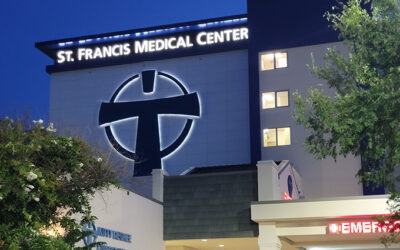Waterfront homes in Louisiana are usually high off the ground because of flooding, and Venessa Chapman’s home on the Ouachita River is no different.
Fifteen steps of a staircase take her from her driveway on the ground floor to the front door each day. Even in her 60s, Venessa was used to making it up the stairs easily. But in the last year, she found herself struggling.
“I had to stop two or three times getting up the steps to catch my breath,” she says.
Though shortness of breath is one of the symptoms of heart disease, it’s also easy to overlook.
Venessa had experienced a heart attack a few years ago but recuperated well with a stent in place.
She saw her primary care physicians regularly to check on her heart with blood work, EKGs and other tests. During the checkups, there were some concerns about the aortic valve in her heart, which is where blood is pumped out of the heart to the rest of the body.
It was showing a decrease in blood flow, but they weren’t yet ready to explore surgery because the only option at the time was open-heart surgery because of her relatively young age. Venessa was particularly fearful of open-heart surgery since she is diabetic, making open-heart surgery riskier with a more difficult recovery.
Still, Venessa noticed more and more how the shortness of breath affected her quality of life. It wasn’t just walking up the steps to her house — it was preventing her from enjoying family vacations or even helping her father navigate the hospital when she accompanied him to his own appointments.
Not long after her 66th birthday in October 2023, she brought her concerns to her cardiologist. Tests now showed the condition of her aortic valve had gone from serious to critical.
The good news: she was eligible for transcatheter aortic valve replacement, or TAVR, because of newly recommended minimum age guidelines.
The minimally invasive procedure would involve two small incisions to implant a valve inside her diseased aortic valve to open it up and increase blood flow. The procedure would have minimal scarring and a much quicker recovery time — an excellent alternative because of her diabetic condition.
Venessa met with interventional cardiologist Nauman Khalid, MD, and cardiothoracic surgeon Sarah Ahmad, MD, part of the heart services team at St. Francis Medical Center. Dr. Khalid and Dr. Ahmad are part of a group of physicians at St. Francis who have together performed more than 200 TAVR procedures since November 11, 2019.
Venessa remembers Dr. Ahmad using the patient exam room to explain how the innovative procedure would help her heart: “She said, ‘Think of this room as your heart.’ Then she walked over to the door and opened it all the way and said, ‘This door opens wide 70 times a minute letting your good blood and oxygen out.’”
Next, Dr. Ahmad left just a crack in the doorway, showing how her diseased valve was only letting a little bit of blood and oxygen out. The new valve would be like the door opening wide again.
It was an effective example that helped calm Venessa’s nerves about the procedure, and in December, Dr. Ahmad and Dr. Khalid, successfully completed her TAVR procedure.
After one night of observation in the hospital, she was able to return home with her family the next day.
Arriving at her house along the river, Venessa surprised herself by climbing those 15 steps to the front door without any problems or any pauses to catch her breath. “I walked up all the way and I was not even slow,” she says. “When you can’t breathe, you don’t know how good that feeling is.”
She’s now able to do the things she loved to do, like shopping with her daughter, without feeling fatigued, and jokes that her daughter has to hurry to keep up with her.
Venessa remembers thinking early on that she would have to travel to Shreveport or out of state for such an advanced procedure as TAVR. But a friend who works in healthcare encouraged her to see Dr. Ahmad, speaking positively of her skills and her way with patients.
Now Venessa encourages others to consider the same care team at St. Francis, and not to shrug off any of the signs and symptoms of heart disease.
She continues to do regular heart checkups with her primary care physician and her cardiologist, Dr. Khalid, as well as cardiac rehabilitation therapy twice a week at St. Francis’ Cardiac Rehabilitation program, which she credits for helping her get active again.
And while she admits that at some point, she and her husband might have to consider installing an elevator at their riverfront home, she’s still perfectly fine walking up those 15 steps on her own.
We were proud to recognize Venessa as the St. Francis Health Warhawk of the Game during a ULM basketball game on February 10. Pictured above with Venessa (center) are members of the St. Francis Medical Group including Dr. Nauman Khalid, interventional cardiologist, Dr. Sarah Ahmad, cardiothoracic surgeon, and NPs Nayana Shrestha and Varun Chauhan. These providers are thrilled to see Venessa doing so well following her TAVR procedure.




